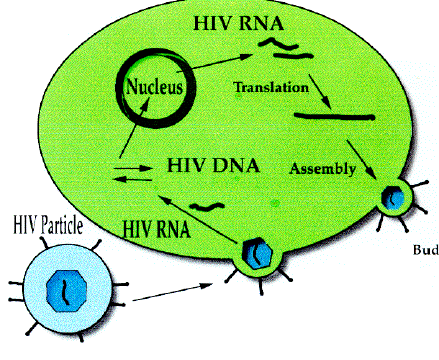|
The
life cycle of HIV in CD4 T cells
- The
virus approaches a CD4 T cell
- The
virus particle attaches, via its glycoproteins, to a specific
receptor protein (CD4) on the T cell.
- Fusion
of the viral envelope with the plasma membrane of the T cell allows
the viral genome and proteins to enter the cytoplasm.
- A
complimentary double-stranded DNA (cDNA) copy of the single-stranded
viral RNA is made using reverse
transcriptase.
- Viral cDNA
enters the nucleus and and is integrated into host DNA by viral
integrase. The intergrated cDNA copy is known as the provirus.
Whenever the cell divides, it also makes a copy of the viral DNA,
increasing the number of infected cells. Until the T cell is activated
the provirus remains dormant.
- T cell activation
leads to transcription of the provirus, by cellular RNA
polymerase.
- Viral proteins
are are made using the host's protein synthesising machinery (Translation)
and viral protease,
which cleaves the viral polyproteins.
- New virus
particles are assembled and bud off from the host cell.
- The T cell
eventually dies.

In patients
infected with HIV, there is continuous production of virus particles
and infection of new cells, this is even the case in HIV-infected
individuals with no symptoms. If the new virus production is halted,
for example using drugs that block virus replication or interfere
with the production of viral proteins, the infected cells die quickly.
HIV seems to be a dynamic disease, infected cells die rapidly, but
are replaced just as quickly with more T cells that in turn become
infected and so keep up virus production.
To see a flash
animation of the process try: http://www.whfreeman.com/kuby/content/anm/kb03an01.htm
|





